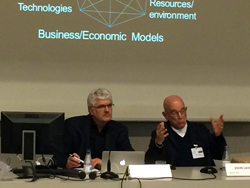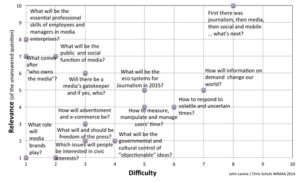IMMAA-Opening Session 2014
- IMMAA Communication
- October 24, 2014
- IMMAA
- 0 Comments
As the opening session of IMMAA 2014 (John Lavine and Christian Scholz), the unusual topic of “Unanswered Questions” has been addressed:
“As academics, we too often respond with <answers> to questions about the future of the media. In the process, we risk create blinders that keep us from focusing on were the media is really headed. We need to spend more time seeking out the underlying drivers fuelling the disruptive changes that accelerate each day, and we need to be more accepting that there are, and should be, unanswered questions; often they are the most important.”
Three landmines prevent moving to and living with difficult, unanswered questions:
- The danger of extrapolation
- The danger of ignoring facts,
- The danger of thinking too conservatively.
These and similar approaches have led to media management academics -and media leaders staying too long with thought-narrowing views of what the media is and will be.
In order to move forward, they introduced a framework that listed a number of the drivers behind potential new questions about the media. It starts with „Business/Economic Models“ and leads all the way to „The Audience”.
After that the IMMAA went through an exercise, which engaged them in locating important “unanswered questions.” After that the attendees voted on the relevance of their ideas as well as which unanswered question was not only highly relevant, but also the most difficult to answer.
That livelily and interesting discussion led to a matrix with a clear winner, which is the question “First there was journalism, then media, then social and mobile … now, what’s next?“
With all the other important issues, all of that signals us paths into a fascinating future of IMMAA.




